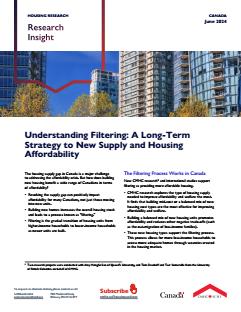Canada’s housing system has a shortage of homes that are affordable to the average household. Building new homes helps increase the overall housing stock supply, which leads to a process called filtering. Filtering is when housing units gradually become available to lower-income households as newer units are built and higher-income households move into these.
Key highlights
- Building mid-cost or a balanced mix of new housing cost types is the most effective way to improve affordability and well-being over the long term.
- This approach allows for more low-income households to access adequate homes through vacancies created in the housing market.
- Relative to a new buildings, rents tend to decrease by about 5% in the first 4 years after construction. This decline reaches nearly 20% after about 20 years. Therefore, as buildings age, they tend to become more affordable for lower-income families.
- Our research and international studies highlight filtering as a long-term approach to providing more housing that is affordable.
- Author:
- CMHC
- Document Type:
- Date Published:
- June 27, 2024







 Share via Email
Share via Email
